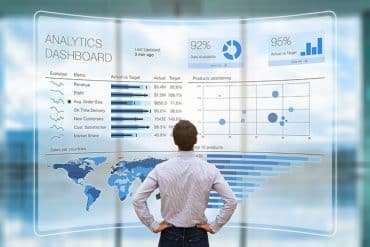The phrase “data analyst” has gained popularity as a result of the increase in data generation. However, there are a set of essential data analyst abilities and a few procedures to follow in order to become a data analyst. In this article on how to become a data analyst, you’ll learn everything you need to know about how to become a data analyst, salary, job, resume and all you need to know.
What is Analytics?
Analytics combines theory and practice to find and communicate data-driven insights that help managers, stakeholders, and other executives make better decisions in their organizations. Experienced data analysts think about their work in a larger context, both within their company and in light of external variables. Analysts can also take into account the competitive climate, internal and external company interests, and the lack of specific data sets when making data-based recommendations to stakeholders.
A Master of Professional Studies in Analytics teaches students about probability theory, statistical modeling, data visualization, predictive analytics, also risk management in the context of a business environment, preparing them for a future as a data analyst. Furthermore, a master’s degree in analytics provides students with the programming languages, database languages, and software packages necessary for a data analyst’s day-to-day employment.
Data Analyst
In order to answer a query or solve an issue, a data analyst collects, cleans, and evaluates data sets. Business, finance, criminal justice, science, medical, and government are just a few of the fields where they can operate.
What types of customers should a company target in its next advertising campaign? What age group is the most susceptible to a specific disease? And what behavioral patterns are linked to financial fraud? As a data analyst, you may be asked to respond to questions like these.
Overview
Data analysts sift through reams of data to find patterns, and projections and extract information that will assist their companies to make better business decisions. As a data analyst, your career path is mostly determined by your employer. On Wall Street, data analysts work for large investment banks, hedge funds, and private equity firms. They also work in marketing, retail, and the healthcare industry. In general, data analysts can be found almost anywhere. They can also be found in huge insurance businesses, credit bureaus, technological corporations, and practically any other industry. Big internet corporations like Facebook and Google analyze massive amounts of data. To accomplish so, they hire several of the best data analysts for a number of objectives, including advertising, internal analysis, and a lot of user research.
The managerial track is the most typical career route for analysts starting out in financial organizations like investment banks. Your supervisors will look to you as someone who can guide the next set of hiring if you demonstrate that you are among the best of your hire group. You could be looking at a career as a department head or vice president if you prove yourself in management.
Data analyst job
The title of data analyst entails a slew of duties and responsibilities. Understanding the responsibilities of a data analyst is the first step in becoming one! The following are some of a data analyst’s most common and expected responsibilities:
#1. Understanding the Goal
A data analyst must first and foremost determine the organization‘s aim. They must evaluate the available resources, analyze the business situation, and gather the necessary information.
#2. Querying
To acquire, store, manipulate, and retrieve data from relational databases such as MS SQL Server, Oracle DB, and MySQL, data analysts construct complex SQL queries and scripts.
#3. Data Mining
This is gathered from a variety of sources and structured in order to extract new information. Data models are created as a result, and the system’s efficiency is improved.
#4. Data Cleansing
A data analyst’s primary responsibilities include data cleaning and wrangling. Initially obtained data is frequently sloppy and contains missing numbers. As a result, it’s critical to clean the data in order to prepare it for analysis.
#5. Data Examining
For a rational study of data, data analysts use analytical and statistical techniques, including computer languages.
#6. Interpreting Data Trends
Data analysts employ a variety of tools and libraries to find trends and patterns in large datasets. Resulting in the discovery of previously unknown business insights.
#7. Preparing Summary Reports
Data analysts use data visualization technologies to create summary reports. These reports help the executive team make informed decisions in a timely manner.
#8. Collaborating with Other Teams
Data analysts interact with the management team, development team, and data scientists to ensure the proper implementation of business requirements. Also, figure out process improvement opportunities.
Data analyst skills
#1. Data Cleaning and Preparation
According to studies, data cleansing and preparation accounts for over 80% of data professionals’ time. As a result, it may be the most important talent for anyone interested in a career in data.
A data analyst will often need to collect data from one or more sources and prepare it for numerical and categorical analysis. Data cleansing also includes dealing with missing or incorrect data that could skew your results.
Although data cleaning isn’t always regarded as “sexy,” it can be a lot of fun when approached as a problem-solving exercise. In any event, it’s where most data projects begin, therefore it’s an important ability to have if you want to work as a data analyst.
#2. Data Analysis and Exploration
It can seem strange to include “data analysis” in a list of data analyst abilities. However, analysis is a distinct talent that must be developed.
At its most basic level, data analysis is converting a business question or need into a data inquiry. To get an answer to that question, you’ll need to transform and evaluate data.
Exploration is another type of data analysis. Data exploration is the process of looking for intriguing trends or relationships in data that could be useful to a company.
Exploration might be prompted by a specific business question, but it can simply be unguided. By looking for patterns and blips in the data, you can discover a way for the company to cut costs or develop!
#3. Statistical Knowledge
A solid understanding of probability and statistics is essential for data analysts. This information will assist you in guiding your research and inquiry, as well as assisting you in comprehending the data you’re working with.
Understanding statistics will also assist you in ensuring the validity of your analysis and avoiding frequent fallacies and logical flaws.
The level of statistical knowledge necessary will vary based on the needs of your profession and the data you’ll be working with. If your business relies on probabilistic analysis, for example, you’ll require a far deeper understanding of those topics than you would otherwise.
#4. Creating Data Visualizations
Data visualizations make it easier to understand trends and patterns in data. Humans are visual beings, and most individuals won’t be able to derive meaningful insight from a massive spreadsheet of data. You’ll need to be able to construct plots and charts as a data analyst to help graphically explain your data and findings.
This entails developing clear, visually appealing charts that will aid in the comprehension of the data by others. It also entails staying away from things that are either difficult to understand (such as pie charts) or can be misleading (like manipulating axis values).
Is Data Analyst a Good Career?
Data analysts that are proficient in their craft are among the most in-demand specialists all across the world. Even entry-level data analysts can command extremely high wages and a variety of attractive benefits due to the high demand for their services and the scarcity of candidates who are qualified to perform the duties of this position effectively.
Both data analysts and data scientists are expected to see above-average job growth in the next years, so keep this in mind if you’re trying to decide which career path to choose. According to ONET OnLine (ONET), the employment prognosis for data analysts is very favorable. Between the years 2020 and 2030, the number of jobs for data analysts is expected to expand by 15%. The amount of money that data analysts make normally is determined by the sector in which they work and the location of their employer. According to O*NET, data analysts earned a yearly wage of approximately $98,230 on average beginning in the year 2020.
Is it Challenging to Work as a Data Analyst?
Data analysis is not a “hard” skill nor a “soft” skill; rather, it is a process that incorporates a combination of both “hard” and “soft” skills. Programming languages such as Python, database tools such as Excel, and data visualization tools such as Tableau are some examples of the technical abilities that a data analyst must possess.
What Should I Learn to Become a Data Analyst?
Data analysts have access to a wide number of tools on a day-to-day basis. Some data analysts make use of software designed for business intelligence. Others may use programming languages and tools such as Python, R, Excel, and Tableau, which each offer a variety of statistical and visualization libraries at their disposal. Other abilities include the ability to think creatively and analytically, communicate effectively, query databases, mine and clean data, and clean data.
Data analyst salary
To translate data into better data-driven business decisions, data analysts utilize mathematical and analytical methodologies. The demand for qualified data analysts to process and understand data is growing as the amount of data available to businesses grows. Data analysts are usually well compensated for their work.
You’ll learn how much data analysts make on average in this article, as well as how several factors like experience, industry, location, and job title might affect your data analyst income. We’ll also discuss some techniques to increase your earning potential if you’re interested in starting or advancing your career as a data analyst.
#1. What is an Average Data Analyst’s Salary?
According to the job listing site Glassdoor, the average base pay for a data analyst in the United States in June 2021 will be $68,583 which may see an increase in 2023. The median annual income for a data analyst is $86,200, according to the US Bureau of Labor Statistics, while the midpoint salary for a data analyst is $103,250, according to human resources consulting firm Robert Half. While the range varies, each of these pay estimates is much higher than the average yearly salary in the United States, which is $56,310. Additionally, as a data analyst, your income will be influenced by a number of things. Let’s look at a few of these factors in more detail.
#2. Data Analyst Salary by Experience
Your amount of experience is one of the most important aspects that might influence your income. In general, the longer you work as a data analyst, the higher your salary will be. According to Glassdoor, four to six years of experience might result in a $2,500 increase in base salary per year, while seven to nine years can result in a $5,800 increase per year.
Taking on a leadership position can help you make more money. According to Glassdoor, analytics managers in the United States make an average of $119,526 per year, while analytics directors earn $150,558 per year.
#3. Data Analyst salaries by industry
Data analytics may be used in almost every industry to make better business decisions. However, the industry in which you choose to work can affect your compensation. The industries with the most demand for data specialists are also the ones that pay the most on average.
According to The Quant Crunch, an IBM report on the demand for data science capabilities, finance and insurance, professional, scientific, and technical services, information technology, management, and manufacturing account for more than three-quarters of data job vacancies.
#4. Data Analyst Salaries by Location
The area in which you live might have a significant impact on how much money you can make as a data analyst. Working in a large metropolis such as San Francisco, New York, Boston, or Washington, DC is usually associated with a higher wage (as well as a higher cost of living). As more organizations employ a geographically scattered workforce (including remote workers), it’s becoming more typical for them to offer location-based salaries that are dependent on where you work rather than your qualifications alone.
What is the Workplace of a Data Analyst like?
The ability to analyze data is in high demand and can lead to exciting careers in both the corporate and governmental sectors. Almost every area imaginable has a need for data analysis; the disciplines of sales, marketing, and healthcare tend to have the most positions available for these individuals at any one time.
Most data analysts work in teams, and a lot of the work is done on the computer. However, depending on the information being collected, some of the tasks may require physical presence at a central location.
Typically, a data analyst’s work week consists of 9 to 5, however, they may be required to put in extra effort on the weekends if a particularly pressing project or deadline is involved.
How Do I Get a Job as a Data Analyst With no Experience?
There are times when even entry-level data analyst positions require candidates to have relevant work experience. However, you can still learn to deal with data even if you haven’t held a data analyst position before. Projects involving real-world data collection and analysis are commonplace in today’s degree, certification, and online education programs. The internet is rife with free data sets you may use to get some hands-on practice with if you’re self-studying (and building your portfolio).
How Long Does it Take to Become a Data Analyst?
How long it takes you to get qualified for a position as a data analyst depends on your starting point, your approach to learning new skills, and the nature of the position you seek. It could, however, take less time than you anticipate. According to Coursera’s 2023 Global Skills Report, you may acquire the knowledge necessary for an entry-level position as a data analyst in about 64 hours of study. It’s possible to complete the coursework for either the Google Data Analytics or IBM Data Analyst Professional Certificate programs in under six months.
Data analyst resume
When it comes to writing the best data science resume, you must pay attention to even the tiniest things. What is the greatest way to begin producing the best data scientist resume?
Make use of the well-known reverse-chronological resume format. This form of data science resume emphasizes your abilities and experience.
According to our HR statistics research, hiring managers typically only glance at each résumé for seven seconds. It’s not enough to be good. Your resume sample for a data scientist must be excellent.
On your professional resume for a data analyst, be sure to employ easy-to-read subheadings, white space, and clear, legible typefaces.
Saving your data analyst resume sample as a PDF is common advice. This preserves your formatting, allowing the job manager to easily understand your data scientist resume.
What Do You Need to Be a Data Analyst?
The majority of data analyst jobs at the entry-level need candidates to have a bachelor’s degree or higher. Data analysis, mathematics, finance, economics, and computer science are all possible choices for academic specializations. The completion of a master’s degree program in data analysis, data science, or business analytics may make it possible to obtain new employment prospects with greater salaries.
What Companies are Hiring for Data Analyst Jobs?
Companies such as Election Systems & Software, Uline, Northrop Grumman, Connec-to-Talk, LLC, Wolfe Eye Clinic, People’s Care/Redwood Family Care Network, MidFirst Bank, Broadcast Music, Inc., Millstone Medical Outsourcing, Intellistars ABA are currently among the most active employers in the market for qualified candidates to fill Data Analyst positions.
What should I search on Glassdoor to find Data Analyst Jobs?
People who searched for employment in the field of data analysis also looked for opportunities in the fields of data specialist, data scientist, business analyst, sales analyst, database analyst, application analyst, SQL analyst, data science, statistical analyst, and tableau developer. If your search is yielding few results, you might want to try expanding the scope of your query. If you are obtaining results that are not related to what you are looking for, try searching with a more restricted and particular keyword.
FAQ
Is data analyst a stressful job?
Data analysis is a stressful job. Although there are multiple reasons, high on the list is the large volume of work, tight deadlines, and work requests from multiple sources and management levels.
Can I become data analyst in 3 months?
If you start your career there, you can work your way up to one of the bigger companies or even start your own data science business. I’ve divided this curriculum up into three months
Do data analyst code?
Some data analysts do use code in their day-to-day duties but it’s typically not required or requires only a basic understanding to help clean and normalize a company’s data.






